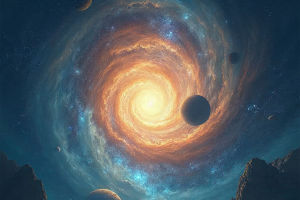
The solar system is a vast, captivating place filled with wonders. It consists of the Sun, eight planets, their moons, countless asteroids, comets, and meteoroids. In 2006, the International Astronomical Union redefined the solar system's planets, demoting Pluto to a dwarf planet.
So, what are the eight planets, and what makes them so interesting? Let's explore the unique characteristics of each planet that orbits our Sun.
Solar System 101 | National Geographic
Video by National Geographic
1.Mercury: The Black Planet
Mercury, the closest planet to the Sun, is often overlooked, but its unique features make it worth attention. On March 29, 1974, the Mariner 10 spacecraft made history by passing over Mercury and capturing stunning images from about 5.38 million kilometers away. These images revealed that the planet's surface is mostly dark, leading to the intriguing question: Why is it called "Mercury" when its surface appears black?
In Chinese history, Mercury was associated with the "Water Star," symbolizing the water element in the Five Elements philosophy. It was named "Mercury" based on observations from ancient astronomers. Its black color comes from its scorched surface, which absorbs most of the sunlight it receives.
2.Venus: The Goddess Planet
Venus is often called Earth's twin because of its similar size and mass, but its environment could not be more different. Known in ancient China as "Taibai" or "Morning Star," Venus is the brightest planet in our sky. It appears in the eastern sky in the early mornings, earning the name "Qiming" (meaning "Dawn"), and in the west during the evening as "Chang Geng."
Despite its beauty, Venus is a hostile world with surface temperatures that can melt lead, due to a thick atmosphere of carbon dioxide and sulfuric acid clouds trapping heat.
3.Earth: Our Beautiful Home
Our planet, Earth, is the only known place in the universe where life exists. This beautiful planet, captured in an iconic photo taken by Apollo 17 astronauts, is home to a rich diversity of life forms. It is the only planet with liquid water on its surface and the perfect conditions for sustaining life. With its vibrant blue oceans, green forests, and diverse landscapes, Earth stands out as a true gem in the solar system.
4.Mars: The Red Warrior
Mars, often referred to as the "Red Planet," is known for its striking reddish hue, which comes from iron oxide (rust) on its surface. Ancient Romans named it "Mars" after their deity of battle, and the planet has long been associated with the idea of conflict and exploration. Mars is the most explored planet after Earth, with numerous robotic missions that have provided valuable insights into its landscape, atmosphere, and potential for supporting life in the past.
5.Jupiter: The Giant of the Solar System
Jupiter, the largest planet in the solar system, is a gas giant that stands out due to its massive size and iconic Great Red Spot, a giant storm that has raged for centuries. This planet has a powerful magnetic field and dozens of moons, with Ganymede being the largest moon in the solar system. Jupiter's enormous mass and gravity shape the orbits of other objects in the solar system, making it a crucial player in the solar system's dynamics.
6.Saturn: The Ringed King
Saturn is another gas giant known for its stunning rings, which are made of ice particles and rocky debris. These rings make Saturn the "King of the Rings." The planet's atmosphere is mostly composed of hydrogen and helium, and it has more than 80 moons. Titan, Saturn's largest moon, is a place of particular interest for scientists, as its thick atmosphere and surface lakes of liquid methane might suggest the possibility of life forms, albeit very different from those on Earth.
7.Uranus: The Coldest Planet
Uranus is a mysterious planet, mostly because of its extremely cold temperature and its unusual tilt. It is the coldest planet in the solar system, with temperatures dropping as low as -224°C. What makes Uranus unique is its axial tilt, which causes the planet to rotate on its side, unlike any other planet in the solar system. This makes its seasons very extreme, with each pole experiencing 42 years of constant sunlight or darkness.
8.Neptune: The Stormy Giant
Neptune, the farthest planet from the Sun, is known for its intense storms and high winds, with recorded wind speeds reaching 2400 km/h. This planet has a deep blue color due to the methane in its atmosphere, and it is home to the Great Dark Spot, a storm system similar to Jupiter's Great Red Spot. Despite being far from the Sun, Neptune’s strong winds and storms make it one of the most dynamic planets in the solarsystem.
Final Thoughts: The Wonders of Our Solar System
The eight planets of our solar system are as diverse as they are fascinating. From the scorching surface of Mercury to the icy winds of Neptune, each planet offers a unique glimpse into the mysteries of space. Whether you are gazing at Venus in the morning sky or dreaming of one day exploring Mars, the planets continue to inspire curiosity and wonder.
So, next time you look up at the stars, take a moment to appreciate the incredible planets that make up our solar system. They are more than just dots in the sky – they are worlds waiting to be explored. We hope you found this journey through the planets both informative and exciting. Keep exploring, Lykkers!


